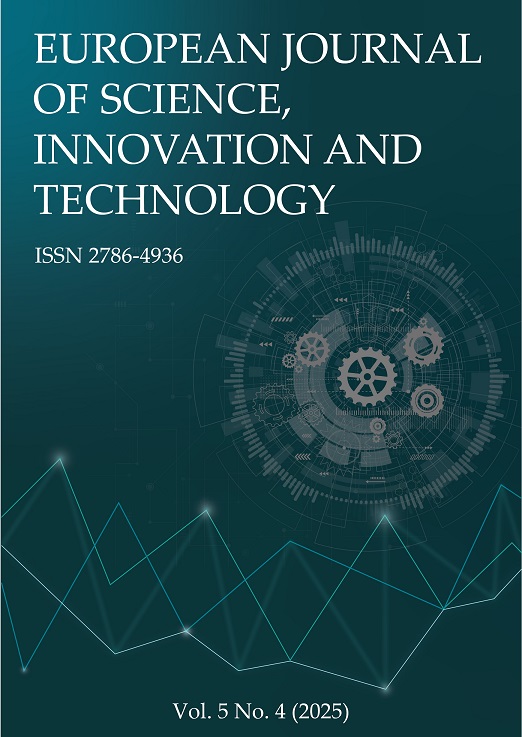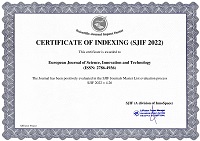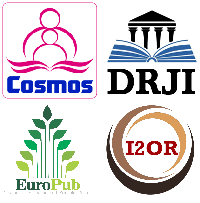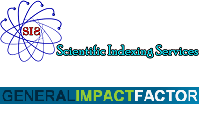Machine Learning in Healthcare
Abstract
Machine learning (ML) has emerged as a center of gravity in the healthcare industry, providing an unequaled capacity to perform prodigious and intricate processes to frame better decisions, diagnoses, and therapies. ML permits early diagnosis of illnesses, predictive analytics of patient outcomes, and individualized treatment planning via utilizing the patterns of the observed data with the implementation of algorithms that can be educated. The paradigm shift is fueled by the speedy expansion of electronic health records (EHRs), medical imaging repositories, wearable device outputs, and genomic datasets. The Healthcare ML applications range widely in scope, with some of their uses being computer vision in treating radiology and pathology, natural language processing to analyze raw clinical notes, population health management, predictive analytics, and others. Next, various operational efficiencies are attained in ML-based scheduling, resource allocation, and fraud detection systems. Nonetheless, implementing ML technology into clinical practice is not problem-free, and the following factors should still be considered: low data quality, bias in the ML model, privacy, and compliance with regulations. Countermeasures against these obstacles in the form of federated learning, explainable AI, and resilient governance systems are on the rise, allowing for more secure and fairer implementation. The paper will summarize principles, essential applications, technical and ethical aspects, and practical case scenarios to comprehensively see ML in the healthcare industry. It also provides an overview of how the intersection of technical innovation and clinical relevance has the potential to transform patient care, as well as amplify the effectiveness of clinical care and have an impact on improving patient health at every level. Finally, achieving this potential ought to necessitate interdisciplinary approaches, critical assessment, and ethical innovation so that ML-based healthcare systems can be precise, responsible, and reflective of patient health.
References
Cantwell, C. D., Mohamied, Y., Tzortzis, K. N., Garasto, S., Houston, C., Chowdhury, R. A., … Peters, N. S. (2019). Rethinking multiscale cardiac electrophysiology with machine learning and predictive modelling. Computers in Biology and Medicine, 104, 339–351. https://doi.org/10.1016/j.compbiomed.2018.10.015
Chen, L., Chen, P., & Lin, Z. (2020). Artificial Intelligence in Education: A Review. IEEE Access, 8, 75264–75278. https://doi.org/10.1109/ACCESS.2020.2988510
Cozzoli, N., Salvatore, F. P., Faccilongo, N., & Milone, M. (2022). How can big data analytics be used for healthcare organization management? Literary framework and future research from a systematic review. BMC Health Services Research, 22(1). https://doi.org/10.1186/s12913-022-08167-z
Currie, G., Hawk, K. E., Rohren, E., Vial, A., & Klein, R. (2019, December 1). Machine Learning and Deep Learning in Medical Imaging: Intelligent Imaging. Journal of Medical Imaging and Radiation Sciences, 50(4), 477-487. https://doi.org/10.1016/j.jmir.2019.09.005
Haenlein, M., & Kaplan, A. (2019). A brief history of artificial intelligence: On the past, present, and future of artificial intelligence. California Management Review, 61(4), 5–14. https://doi.org/10.1177/0008125619864925
Hassabis, D., Kumaran, D., Summerfield, C., & Botvinick, M. (2017, July 19). Neuroscience-Inspired Artificial Intelligence. Neuron, 95(2), 245-258. https://doi.org/10.1016/j.neuron.2017.06.011
Islam, M. S., Hasan, M. M., Wang, X., Germack, H. D., & Noor-E-alam, M. (2018, June 1). A systematic review on healthcare analytics: Application and theoretical perspective of data mining. Healthcare, 6(2), 54. https://doi.org/10.3390/healthcare6020054
Janiesch, C., Zschech, P., & Heinrich, K. (2021). Machine learning and deep learning. Electronic Markets, 31(3), 685–695. https://doi.org/10.1007/s12525-021-00475-2
Johnson, K. W., Torres Soto, J., Glicksberg, B. S., Shameer, K., Miotto, R., Ali, M., … Dudley, J. T. (2018, June 12). Artificial Intelligence in Cardiology. Journal of the American College of Cardiology, 71(23), 2668–2679. https://doi.org/10.1016/j.jacc.2018.03.521
Korteling, J. E. (Hans), van de Boer-Visschedijk, G. C., Blankendaal, R. A. M., Boonekamp, R. C., & Eikelboom, A. R. (2021). Human- versus Artificial Intelligence. Frontiers in Artificial Intelligence, 4. https://doi.org/10.3389/frai.2021.622364
Kuhn, M., & Johnson, K. (2013). Applied predictive modeling. Applied Predictive Modeling (pp. 1–600). Springer New York. https://doi.org/10.1007/978-1-4614-6849-3
Kutyauripo, I., Rushambwa, M., & Chiwazi, L. (2023). Artificial intelligence applications in the agrifood sectors. Journal of Agriculture and Food Research, 11. https://doi.org/10.1016/j.jafr.2023.100502
Lu, G., & Fei, B. (2014). Medical hyperspectral imaging: a review. Journal of Biomedical Optics, 19(1), 010901. https://doi.org/10.1117/1.jbo.19.1.010901
Lundervold, A. S., & Lundervold, A. (2019, May 1). An overview of deep learning in medical imaging focusing on MRI. Zeitschrift Fur Medizinische Physik, 29(2), 102-127. https://doi.org/10.1016/j.zemedi.2018.11.002
Marmion, M., Parviainen, M., Luoto, M., Heikkinen, R. K., & Thuiller, W. (2009). Evaluation of consensus methods in predictive species distribution modelling. Diversity and Distributions, 15(1), 59–69. https://doi.org/10.1111/j.1472-4642.2008.00491.x
Maxwell, A. E., & Shobe, C. M. (2022, March 1). Land-surface parameters for spatial predictive mapping and modeling. Earth-Science Reviews, 226, 103944. https://doi.org/10.1016/j.earscirev.2022.103944
Mehta, N., & Pandit, A. (2018, June 1). Concurrence of big data analytics and healthcare: A systematic review. International Journal of Medical Informatics, 114, 57-65. https://doi.org/10.1016/j.ijmedinf.2018.03.013
Pandey, B., Kumar Pandey, D., Pratap Mishra, B., & Rhmann, W. (2022, September 1). A comprehensive survey of deep learning in the field of medical imaging and medical natural language processing: Challenges and research directions. Journal of King Saud University - Computer and Information Sciences, 34(8), Part A, 5083-5099. https://doi.org/10.1016/j.jksuci.2021.01.007
Raghupathi, W., & Raghupathi, V. (2014, February 7). Big data analytics in healthcare: Promise and potential. Health Information Science and Systems, 2, 3. https://doi.org/10.1186/2047-2501-2-3
Ristevski, B., & Chen, M. (2018). Big Data Analytics in Medicine and Healthcare. Journal of Integrative Bioinformatics, 15(3). https://doi.org/10.1515/jib-2017-0030
Rolnick, D., Donti, P. L., Kaack, L. H., Kochanski, K., Lacoste, A., Sankaran, K., … Bengio, Y. (2023, February 28). Tackling Climate Change with Machine Learning. ACM Computing Surveys, 55(2), 42. https://doi.org/10.1145/3485128
Sarker, I. H. (2021, May 1). Machine Learning: Algorithms, Real-World Applications and Research Directions. SN Computer Science, 2, 160. https://doi.org/10.1007/s42979-021-00592-x
Shahbaz, M., Gao, C., Zhai, L. L., Shahzad, F., & Hu, Y. (2019). Investigating the adoption of big data analytics in healthcare: the moderating role of resistance to change. Journal of Big Data, 6(1). https://doi.org/10.1186/s40537-019-0170-y
Shamshad, F., Khan, S., Zamir, S. W., Khan, M. H., Hayat, M., Khan, F. S., & Fu, H. (2023, August 1). Transformers in medical imaging: A survey. Medical Image Analysis, 88, 102802. https://doi.org/10.1016/j.media.2023.102802
Shmueli, G. (2010). To explain or to predict? Statistical Science, 25(3), 289–310. https://doi.org/10.1214/10-STS330
Shurrab, S., & Duwairi, R. (2022). Self-supervised learning methods and applications in medical imaging analysis: a survey. Peer J Computer Science, 8. https://doi.org/10.7717/PEERJ-CS.1045
Stavropoulou, E., & Bezirtzoglou, E. (2019, December 6). Predictive modeling of microbial behavior in food. Foods, 8(12), 654. https://doi.org/10.3390/foods8120654
Thiebes, S., Lins, S., & Sunyaev, A. (2021). Trustworthy artificial intelligence. Electronic Markets, 31(2), 447–464. https://doi.org/10.1007/s12525-020-00441-4
Verbraeken, J., Wolting, M., Katzy, J., Kloppenburg, J., Verbelen, T., & Rellermeyer, J. S. (2021, March 31). A Survey on Distributed Machine Learning. ACM Computing Surveys, 53(2), 30. https://doi.org/10.1145/3377454
Von Rueden, L., Mayer, S., Beckh, K., Georgiev, B., Giesselbach, S., Heese, R., … Schuecker, J. (2023). Informed Machine Learning - A Taxonomy and Survey of Integrating Prior Knowledge into Learning Systems. IEEE Transactions on Knowledge and Data Engineering, 35(1), 614–633. https://doi.org/10.1109/TKDE.2021.3079836
Xu, Y., Zhou, Y., Sekula, P., & Ding, L. (2021). Machine learning in construction: From shallow to deep learning. Developments in the Built Environment, 6. https://doi.org/10.1016/j.dibe.2021.100045
Yang, C. C. (2022). Explainable Artificial Intelligence for Predictive Modeling in Healthcare. Journal of Healthcare Informatics Research, 6(2), 228–239. https://doi.org/10.1007/s41666-022-00114-1
Yi, X., Walia, E., & Babyn, P. (2019). Generative adversarial network in medical imaging: A review. Medical Image Analysis, 58. https://doi.org/10.1016/j.media.2019.101552
Zhou, L., Song, Y., Ji, W., & Wei, H. (2022). Machine learning for combustion. Energy and AI, 7. https://doi.org/10.1016/j.egyai.2021.100128
Copyright (c) 2025 Ahmed Karam

This work is licensed under a Creative Commons Attribution 4.0 International License.


 ISSN
ISSN 











